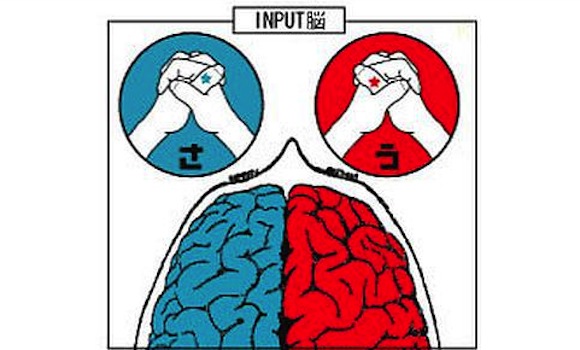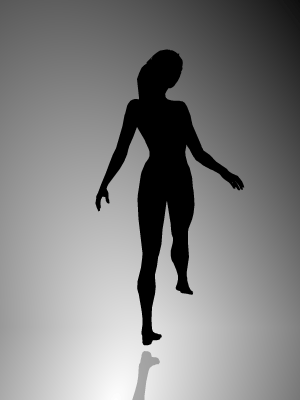
Everybody, go ahead and cross your arms right now. Done? Alright. Now, try to cross them the other way. If you’re currently crossed with right forearm on top, try to switch position so that your left forearm is on top. Feels incredibly awkward and unnatural, doesn’t it?
It turns out most people have a natural bias for arm-crossing direction, with slightly more than half of most global populations preferring the left-forearm-on-top approach, although the two preferences are basically 50-50. Some people apparently cross their arms either way without even thinking about it, although this population is exceedingly small.
So why do we humans find one way so natural and the other way so incredibly weird-feeling? It may have something to do with your psychological composition, according to the (admittedly somewhat unreliable) Japanese Internet.
This graph breaks it down:
Here we see a cross-section of personality type and arm-crossing and finger-weaving preference. To figure out your finger-weaving preference, interlock your fingers like you’re Oliver Twist begging for more porridge and pay attention to which thumb is on top; You’ll obviously be either right-thumbed or left-thumbed.
Let’s take a look at a breakdown of what each category means:
If you both cross your arms and weave your hands right-over-left, you apparently are inclined to think critically before arriving at a first impression, and think critically when confronting problems or drawing deeper conclusions.
Those that cross their arms right-over-left, but weave hands left-over-right tend to go with their gut when it comes to first impressions, but give more logical thought to things when drawing deeper conclusions or confronting a problem that needs solved.
Left-over-right arm-crossing hand-weavers are supposedly the most brash of the bunch, leaving everything up to gut instinct.
Finally, if you tend to cross your arms left-over-right but weave your hands right-over-left, then your first impressions tend to be well-thought out, while you leave more complex issues to instinct.
For further proof, here’s a diagram about left-brain and right-brain or something:
Here’s the part where I’m supposed to tell you that I tried this myself and found that my arm-crossing and hand-weaving preferences and problem-solving style matched closely with the conclusions drawn by these diagrams, but that’s actually not what happened.
In fact, it appears arm-crossing and hand-weaving preferences are largely random, probably chosen by each individual as a child when first learning to perform these actions and reinforced over many years until going the opposite direction starts to feel very unnatural. Family studies have borne this out, with right-over-left-preferring parents giving birth to left-over-right-preferring kids about 50% of the time, and vice versa. Even more damning to the theory put forward by the above diagrams, twins have opposite arm and hand-folding preferences about as often as they have the same preferences, strongly indicating that genetics don’t influence an individual’s preference and, subsequently, that it’s probably not a strong indicator of psychological tendencies.
Apparently, some people also believe that this Geocities-era Internet spam .gif is an accurate predictor of left or right-brained-ness:
Never mind that the dancer frequently switches spinning direction the more you look at it.
But hey, it’s fun to think about it, right? And it’s at least (probably, ever so slightly) more scientifically sound than trying to read the future in animal bones.
Source and photos: Kininaru Sokuhou




 Are you a control freak, baby, or tough guy? Find out what your sleeping position says about you!
Are you a control freak, baby, or tough guy? Find out what your sleeping position says about you! Going over the top with a lesson at Tokyo’s top arm wrestling dojo【Photos】
Going over the top with a lesson at Tokyo’s top arm wrestling dojo【Photos】 Retro game personality test: What the way you wrapped your N64 controller cord says about you
Retro game personality test: What the way you wrapped your N64 controller cord says about you An illustrated guide to the proper way to give and receive business cards in Japan
An illustrated guide to the proper way to give and receive business cards in Japan 8 things you should never say to a Japanese person
8 things you should never say to a Japanese person We eat 13 of the most highly recommended sushi items at Sushiro and pick the best of the best
We eat 13 of the most highly recommended sushi items at Sushiro and pick the best of the best We found possibly the quietest Japanese-style hotel in Tokyo’s bustling Shinjuku district
We found possibly the quietest Japanese-style hotel in Tokyo’s bustling Shinjuku district Here are the top ten foodie factory tours for the fall throughout Japan
Here are the top ten foodie factory tours for the fall throughout Japan Is this the most relaxing Starbucks in Japan?
Is this the most relaxing Starbucks in Japan? Brand-new theme park in Japan charges foreign tourists 25 percent more than locals for tickets
Brand-new theme park in Japan charges foreign tourists 25 percent more than locals for tickets What’s on the all-you-can-drink menu at Denny’s Japan? 【Family Restaurant Drink Bar Showdown】
What’s on the all-you-can-drink menu at Denny’s Japan? 【Family Restaurant Drink Bar Showdown】 This beautiful Nara inn was once home to a Living National Treasure
This beautiful Nara inn was once home to a Living National Treasure Tokyo Station staff share their top 10 favorite ekiben
Tokyo Station staff share their top 10 favorite ekiben KFC Japan opens a Christmas restaurant in Tokyo…but why???
KFC Japan opens a Christmas restaurant in Tokyo…but why??? Life-size Mewtwo, graffiti Pikachu welcome us to the newest Pokémon Center megastore in Shibuya
Life-size Mewtwo, graffiti Pikachu welcome us to the newest Pokémon Center megastore in Shibuya Starbucks Japan ready to get Year of the Horse started with adorable drinkware and plushies【Pics】
Starbucks Japan ready to get Year of the Horse started with adorable drinkware and plushies【Pics】 7-Eleven Japan’s ramen-cooking robot whipped us up a bowl of noodles【Taste test】
7-Eleven Japan’s ramen-cooking robot whipped us up a bowl of noodles【Taste test】 Lacquerware supplier to emperor of Japan and Pokémon team up for new tableware
Lacquerware supplier to emperor of Japan and Pokémon team up for new tableware Cyberpunk anime meets traditional culture in Ghost in the Shell gold leaf Japanese changing screens
Cyberpunk anime meets traditional culture in Ghost in the Shell gold leaf Japanese changing screens 7 great places to see Mt. Fuji from without having to climb it
7 great places to see Mt. Fuji from without having to climb it Japan may add Japanese language proficiency, lifestyle classes to permanent foreign resident requirements
Japan may add Japanese language proficiency, lifestyle classes to permanent foreign resident requirements Hello Kitty Choco Egg figures are an adorable trip through three periods of Japanese pop culture【Pics】
Hello Kitty Choco Egg figures are an adorable trip through three periods of Japanese pop culture【Pics】 Japan’s otoshidama tradition of giving kids money at New Year’s gets a social welfare upgrade
Japan’s otoshidama tradition of giving kids money at New Year’s gets a social welfare upgrade Starbucks Japan releases new zodiac chilled cup drink for 2026
Starbucks Japan releases new zodiac chilled cup drink for 2026 Can a dirty butthole make you filthy rich in Japan? We’re starting a New Year’s lottery experiment
Can a dirty butthole make you filthy rich in Japan? We’re starting a New Year’s lottery experiment 7-Eleven Japan starts new temporary luggage storage service in over 300 branches
7-Eleven Japan starts new temporary luggage storage service in over 300 branches Disillusionment at Tsukiji’s tourist-target prices led us to a great ramen restaurant in Tokyo
Disillusionment at Tsukiji’s tourist-target prices led us to a great ramen restaurant in Tokyo Starbucks teams up with 166-year-old Kyoto doll maker for Year of the Horse decorations【Photos】
Starbucks teams up with 166-year-old Kyoto doll maker for Year of the Horse decorations【Photos】 Tokyo considering law requiring more trash cans following litter increase in heavily touristed area
Tokyo considering law requiring more trash cans following litter increase in heavily touristed area Tokyo’s Tsukiji sushi neighborhood asks tour groups to stay away for the rest of the month
Tokyo’s Tsukiji sushi neighborhood asks tour groups to stay away for the rest of the month Nintendo’s Kirby now delivering orders at Kura Sushi restaurants, but not in Japan
Nintendo’s Kirby now delivering orders at Kura Sushi restaurants, but not in Japan Tokyo event lets you travel back in time, for free, to celebrate 100 years since Showa era start
Tokyo event lets you travel back in time, for free, to celebrate 100 years since Showa era start Sanrio theme park in Japan announces plans to expand into a Sanrio resort
Sanrio theme park in Japan announces plans to expand into a Sanrio resort Stamina-destroying “Paralysis Noodles” are Tokyo’s newest over-the-top ramen innovation
Stamina-destroying “Paralysis Noodles” are Tokyo’s newest over-the-top ramen innovation Survey asks foreign tourists what bothered them in Japan, more than half gave same answer
Survey asks foreign tourists what bothered them in Japan, more than half gave same answer Japan’s human washing machines will go on sale to general public, demos to be held in Tokyo
Japan’s human washing machines will go on sale to general public, demos to be held in Tokyo Japan’s deadliest food claims more victims, but why do people keep eating it for New Year’s?
Japan’s deadliest food claims more victims, but why do people keep eating it for New Year’s? We deeply regret going into this tunnel on our walk in the mountains of Japan
We deeply regret going into this tunnel on our walk in the mountains of Japan Studio Ghibli releases Kodama forest spirits from Princess Mononoke to light up your home
Studio Ghibli releases Kodama forest spirits from Princess Mononoke to light up your home Major Japanese hotel chain says reservations via overseas booking sites may not be valid
Major Japanese hotel chain says reservations via overseas booking sites may not be valid Put sesame oil in your coffee? Japanese maker says it’s the best way to start your day【Taste test】
Put sesame oil in your coffee? Japanese maker says it’s the best way to start your day【Taste test】 No more using real katana for tourism activities, Japan’s National Police Agency says
No more using real katana for tourism activities, Japan’s National Police Agency says Starbucks Japan reveals new sakura drinkware collection, inspired by evening cherry blossoms
Starbucks Japan reveals new sakura drinkware collection, inspired by evening cherry blossoms Updated cherry blossom forecast shows extra-long sakura season for Japan this year
Updated cherry blossom forecast shows extra-long sakura season for Japan this year You can turn half your arm into Eva Unit-01 with the crazy Evangelion drink holder
You can turn half your arm into Eva Unit-01 with the crazy Evangelion drink holder Four things to think about before you and your Japanese sweetheart tie the knot
Four things to think about before you and your Japanese sweetheart tie the knot We take a giraffe nap in a standing sleep pod at a cafe in Tokyo
We take a giraffe nap in a standing sleep pod at a cafe in Tokyo Sandwiched Between Twintails Pillow: For if you don’t know to hug your pillow or let it hug you
Sandwiched Between Twintails Pillow: For if you don’t know to hug your pillow or let it hug you The disembodied arm on the shoulder prank in the office shows you can be too good at something
The disembodied arm on the shoulder prank in the office shows you can be too good at something Does Avril Lavigne’s Tokyo music video really have anything to do with Japan?
Does Avril Lavigne’s Tokyo music video really have anything to do with Japan? We put the internet’s “techniques for emptying your bladder with morning wood” to the test
We put the internet’s “techniques for emptying your bladder with morning wood” to the test How to tell if your cat is left- or right-handed【Video】
How to tell if your cat is left- or right-handed【Video】 Another sensible purchase: Replica Mega Man arm cannon can be yours for just $80!
Another sensible purchase: Replica Mega Man arm cannon can be yours for just $80! Heart-shaped lemons from Hiroshima make sour a little sweeter
Heart-shaped lemons from Hiroshima make sour a little sweeter How’s It Hangin’ Japan? “To the Left,” Say About 40% of Guys
How’s It Hangin’ Japan? “To the Left,” Say About 40% of Guys [Quiz] How Well Do You Know Your Japanese Hand Gestures?
[Quiz] How Well Do You Know Your Japanese Hand Gestures? Virtual YouTuber finds a way to shake hands with real-world fans, give them high-fives in Japan
Virtual YouTuber finds a way to shake hands with real-world fans, give them high-fives in Japan Long wallet or bifold? What your wallet says about you in Japan
Long wallet or bifold? What your wallet says about you in Japan
Leave a Reply